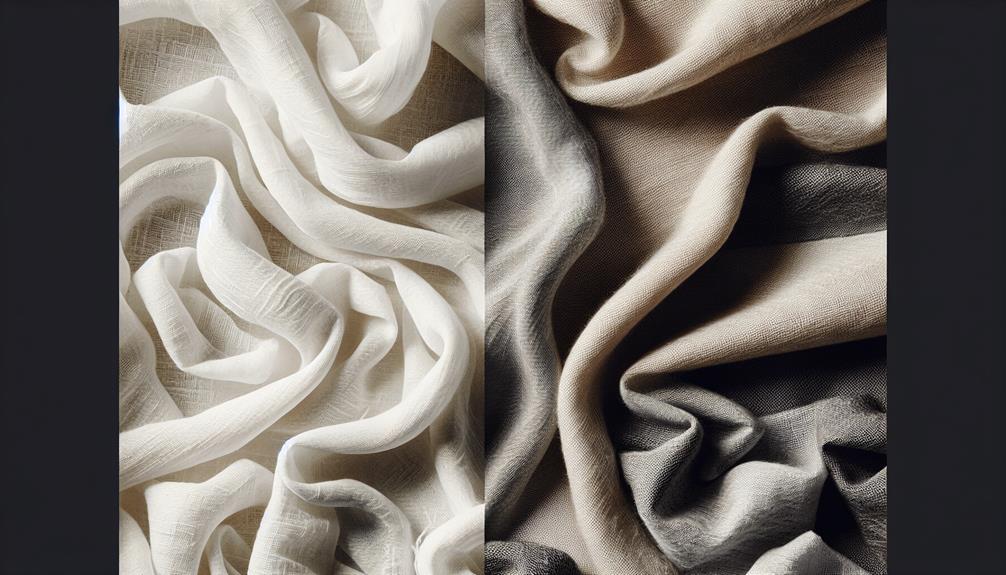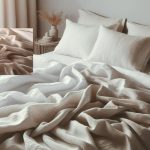Linen outshines cotton in luxury. Its stronger fibers are 30% more durable, and it can absorb 20% of its weight in moisture. The luster and drape of linen add to its allure. Plus, it gets softer with use, getting even better over time. But hey, there's more to know about the whole linen versus cotton debate.
Table of Contents
Key Takeaways
- Linen's superior strength and luster make it more luxurious than cotton.
- The exclusivity and labor-intensive production process elevate linen's prestige.
- Linen softens with use while maintaining shape, adding to its luxury.
- Linen's durability, absorbency, and longevity surpass cotton, enhancing its luxurious appeal.
- Linen's cooling abilities and skin-friendly properties make it a more luxurious choice.
Luxurious Qualities of Linen
Linen exudes luxury through its exclusive European sourcing, particularly from Belgium. Its luxurious qualities set it apart from cotton in many ways. The strong and heavy linen fibers, which are about 30% stronger than cotton, add to its premium appeal. What makes linen even more luxurious is its exceptional absorbency, capable of soaking up to 20% of its weight in moisture. This absorbency not only adds to its comfort but also contributes to its longevity.
Moreover, the luster and luxurious drape of linen fabric elevate its status in the textile industry. The premium feel and experience that linen provides are unmatched. Linen softens and improves with use, ensuring that it gets better over time. Its exclusive European origins and these luxurious qualities make linen a top choice for those seeking sophistication and elegance in their textiles.
Luxurious Qualities of Cotton
When it comes to luxurious qualities in textiles, cotton stands out for its unmatched softness and comfort, making it a popular choice for a wide range of everyday clothing and bedding.
High-quality cotton can be woven into luxurious high thread count fabrics, providing a silky feel and elegant appearance. The breathability of cotton is exceptional, allowing for air circulation and comfort, which is particularly beneficial in warmer climates.
Its versatility is another key feature, as cotton is suitable for all seasons, offering a cozy and inviting feel in various settings. Additionally, cotton is easy to care for and maintain, making it a practical and convenient option for everyday use.
Whether you're looking for a breathable fabric, luxurious high thread count sheets, or simply seeking comfort and style, cotton is a top choice that combines all these desirable qualities effortlessly.
Durability and Longevity Comparison
Compared to cotton, a key advantage of linen lies in its superior strength and durability, ensuring long-lasting quality in textiles. Linen's thicker fibers make it approximately 30% stronger than cotton, requiring a lower thread count for the same quality, which enhances its longevity. While cotton is more breathable and slightly more moisture absorbent than linen, linen is known for its exceptional absorbency, longevity, and luster. The durability of linen makes it a wise choice for items that require strength and resilience over time.
| Features | Linen | Cotton |
|---|---|---|
| Strength | Superior | Less |
| Thread Count | Lower | Higher |
| Breathability | Moderate | High |
| Moisture Absorbency | Good | Excellent |
| Longevity | Durable | Less durable |
In terms of durability and longevity, linen emerges as the frontrunner due to its robust nature and lower thread count requirements, ensuring that linen textiles maintain their quality and strength over time.
Comfort and Breathability Analysis
Moving from the discussion on durability and longevity, let's now explore the comfort and breathability aspects of these fabrics.
Linen's breathability and moisture-wicking properties make it a top choice for hot climates, keeping you cool and comfortable. Its natural fibers allow for excellent air circulation, reducing the risk of overheating.
On the other hand, cotton, while breathable and soft, may not offer the same cooling effect as linen due to differences in fiber structure. Cotton can feel warmer initially and retains more body heat than linen.
The breathability of linen not only enhances its luxurious feel but also contributes to better temperature regulation and skin-friendly properties. When it comes to comfort, linen stands out with its cooling abilities and airy feel, making it a preferred option for those seeking a fabric that keeps them feeling fresh and comfortable, especially in warm weather conditions.
Final Verdict: Linen Vs. Cotton
Let's explore the ultimate clash between linen and cotton to determine which fabric truly reigns supreme.
Linen, derived from flax fibers, exudes luxury with its prestigious reputation, durability, and natural allure. This fabric stands out for its exclusivity, stemming from the labor-intensive production process that imparts a unique texture and timeless elegance. Linen's ability to soften with each wash while maintaining its shape over time further solidifies its position as a luxurious choice.
In contrast, cotton, though soft and versatile, lacks the same level of sophistication and prestige associated with linen. Linen's historical ties to nobility, higher production costs, and sustainable properties elevate it as a fabric of choice for those seeking luxury.
When it comes down to it, linen emerges as the more luxurious option, offering a blend of exclusivity, durability, and natural charm that surpasses the appeal of cotton in the world of high-end fabrics.
Frequently Asked Questions
Is Linen Considered Luxury?
Yes, linen is considered luxury. Its exclusive production process, premium quality, and historical prestige elevate its status. Luxury brands use linen for its sophistication. The rarity of high-quality linen fibers enhances its desirability.
Is Linen Nicer Than Cotton?
Linen is nicer than cotton for its luxurious feel and exclusive reputation. Its durability, absorbency, and softening with time make it a top choice. The limited availability and labor-intensive process add to its allure.
Why Choose Linen Over Cotton?
Choosing linen over cotton is a no-brainer for me. Its luxurious feel, breathability, and durability make it a top pick. Plus, the way it softens and improves with time adds to the comfy, upscale vibe.
Why Does Linen Look Expensive?
Linen looks expensive due to its labor-intensive production process, high-quality raw materials like flax fibers, eco-friendly practices, and timeless elegance. These factors, along with market demand for sustainable luxury, contribute to linen's perceived value.
- Why Is Red Velvet Not Red? - April 25, 2024
- How Do You Describe Velvet Fabric? - April 25, 2024
- How Strong Is Velvet? - April 25, 2024






